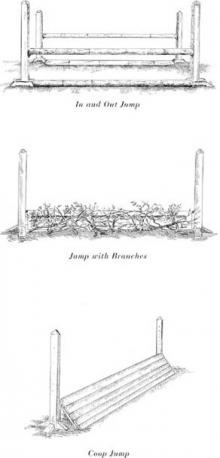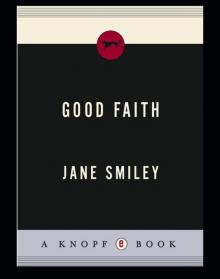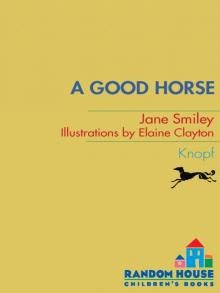- Home
- Jane Smiley
Charles Dickens Page 9
Charles Dickens Read online
Page 9
The death of David’s mother ends his schooling at Creakle’s institution. He returns to Blunderstone for the funeral and subsequently is sent to work at the counting house of Murdstone and Grinby, wine merchants. He lodges with the Micawbers, but soon Mr. Micawber is arrested for debt and the Micawbers move into the King’s Bench Prison. Of his working life, David notes, “All this time I was working at Murdstone and Grinby’s in the same common way, and with the same common companions, and with the same ceaseless sense of unmerited degradation as at first. But I never, happily for me no doubt, made a single acquaintance, or spoke to any of the many boys whom I saw daily in going to the warehouse, in coming from it, and in prowling about the streets at meal-times. I led the same secretly unhappy life; but I led it in the same lonely, self-reliant manner.” The contrast to Dickens’s own life is specific. The Micawbers are comic representations of his parents; the counting house, while tedious and unpleasant, is not quite as appalling as the blacking factory. In fact, when Murdstone speaks to David before sending him out to work, he says something Dickens himself might have said: “To the young this is a world for action, and not for moping and droning in.” The point is that David feels uncared for. It is not that he must make his way, but that no one cares whether and how he makes his way. Even the Micawbers are so wrapped up in their own affairs that David’s ups and downs are of little moment to them. Certainly this is a true reflection of how Dickens experienced his parents when they were having difficulties—however pleasant and agreeable they were upon occasion, they were capable of no real understanding of or sympathy with him; it was as if he were simply their lodger.
David Copperfield evokes Dickens’s life without relating it. The fiction frees him to contemplate not only his boyhood and young manhood, but boyhood and young manhood in general. David’s task is simultaneously a moral one and an emotional one—to find true companionship but also to assume responsibility for one’s choices and their consequences. Through observing those around him and also weighing his own actions and choices, David attains responsible manhood: at the end of the novel, he has a respectable career, good friends, and a soul mate in Agnes, who is often criticized for being dull and one-dimensional but is an interesting evocation of a quiet, self-contained, and responsible feminine presence. David succeeds fully where Dickens himself succeeded only partially—he was beginning to confide in Forster that he despaired of ever finding true intimate companionship.
The tenor of David Copperfield is comic, but because its great subject is David’s moral education, the happy ending does not quite balance out the costs of getting there. David and Agnes find each other, David’s other loved ones live in prosperity and amity, Em’ly, Martha, and the Micawbers leave the scenes of their defeats to find new opportunities elsewhere. But Steerforth is lost, the Peggottys’ lives are destroyed, and even Heep’s defeat has a sour taste about it. The natural tendency of individuals to live in isolation through selfishness, greed, addiction, despair, and self-delusion is not generally mitigated—it is mitigated only in David’s case, at least partly because he is lucky enough to find Agnes. There is no suggestion that he deserves Agnes, except insofar as he has learned enough to value her.
Both Dombey and Son and David Copperfield are great novels, but they succeed in part because they have backed away from larger social issues and allowed their protagonists to resolve problems that are representative of large social forces and dilemmas only as individuals. For a novel, such an individual solution is the only believable one, the only “realistic” one. At the same time, though, Dombey and David come to seem Cinderella-like—the form of the comic novel itself chooses them to prevail while all around them others succumb. The solution that Dickens bodies forth in each of his Christmas books, that of a change in a character’s inner life creating outward change, works better as a parable than it does as a novel, because a novel needs more action to carry it than a single miraculous inner shift. As characters in a novel act upon one another and make their way in the world, the vivid sense of a single inner life is overwhelmed by the varied and multifarious strands of the narrative. Novels are both too short and too long. They are too short to reproduce, in rigorous depth, the moral development of more than a handful of characters, and too long to meditate upon philosophical issues without plenty of action to give those issues some narrative liveliness. Nevertheless, Dickens persisted in attempting to broaden and deepen the social meaning of his work, and of the novel itself, as subsequent works show.
David Copperfield ran from May 1849 to November 1850. Dickens was famously affected by its completion. He wrote in the preface, “An author feels as if he were dismissing some portion of himself into the shadowy world, when a crowd of the creatures of his brain are going from him forever.” Reviews were at first mixed, and sales of the numbers not as good as those of Dombey and Son, but sales in volume form were good, and readers came around more and more to Dickens’s own love for the novel. It has since become the quintessential Dickens novel, the easiest, the most appealing, the most frequently known for itself rather than through stage productions or movies. Between them, we may say, Dombey and Son and David Copperfield relieved Dickens of two of his profoundest anxieties—financial worries and residual fears from his youth. Both reconfirmed his continuing importance among contemporary novelists. In the next phase of his career, his relationships to everyone around him would shift as he built upon what Dombey and Copperfield had taught him.
CHAPTER FOUR
THE PERIOD while Dickens was writing David Copperfield was exceptionally productive even for him. At the end of 1849 he began to develop a new weekly periodical that came to be known as Household Words, “conducted by Charles Dickens.” The first issue appeared on March 30, 1850. From this time forward, for some twenty years, he edited, wrote for, and profited from either this weekly magazine or his next one, All the Year Round. His editorship was active and informed, as well as lucrative, since he owned half of the magazine (which had a circulation of about thirty-five thousand), was paid £500 a year for editing it, and was also paid for contributions. He estimated that in 1850 alone he read nine hundred manuscripts, of which he accepted only a handful. His target audience with the magazine was the reading middle class that formed his earliest core audience, not intellectuals or artists or reformers, but a general readership that liked to be entertained and informed. He gathered around him a group of writers, who contributed anonymously. The only ones we know today were Wilkie Collins, author of The Woman in White and The Moonstone, and Elizabeth Gaskell, author of North and South and Mary Barton. Though not all of them liked the anonymity, one thing about working for Dickens appealed to all of them—he paid generously and quickly. He was also generous with editorial advice and even rewriting, which suited some authors more than others. But he had a particular vision—of informative articles and essays made more lively by his favorite mental activity, “fancy,” and he was resolute in his assertion of his vision. As with the plays he directed and stage-managed, he felt responsible for every aspect of the production, but he also brought imagination, insight, and charm to working with the other egos involved. The many extant letters that he wrote to his authors attest to these qualities. As with his earlier forays into journalism, he was still attracted to “theme” issues—he would propose a theme, such as Christmas, and then he would write the opening and closing pieces while others would contribute variations on the theme (this had been the original idea behind Master Humphrey’s Clock). In general, he worked to balance each issue, so essays taken out of context now can seem rather odd in tone, but as always, Dickens’s primary artistic goal was to produce a first-rate whole. In the case of Household Words, which came out every Wednesday, the parts were secondary. At first Dickens worked with the assistance of John Forster. For most of his career, Dickens consulted Forster about all aspects of his work, from artistic choices to business concerns, and all of the novels show the effects of Forster’s taste, which Dickens relied upon but in so
me cases overruled. Forster, who had an eighth share, and Dickens worked on Household Words together, apparently amicably at first, although they were beginning to disagree, because Forster’s life and politics were growing more conservative.
With Household Words, Dickens became, if possible, more central to English literary life, because he accepted and published work by younger writers, who, according to most authorities, cherished even his rejection letters, they were so kind and full of support. He knew, and they knew, too, that he was “the Master.” But he was by no means universally adored. Elizabeth Gaskell complained that Household Words was always “Dickensy.” Even so, there were plenty of periodicals now, and novels, too, that were not by Dickens, or “Dickensy.” We may say that he had built the mansion, but the mansion had come to have many rooms.
On August 16, Dickens’s third daughter and ninth child was born. Dickens was just at that point in David Copperfield where he had to decide the fate of David’s wife, Dora, and at around the same time that he decided she must die, he named his new baby Dora, which has caused some comment among biographers and, indeed, caused comment at the time. On the very afternoon of the birth, Dickens and the other children and Georgina Hogarth traveled from London to the family’s usual summer resort, at Broadstairs. Catherine and the baby stayed home.
The third great enterprise in Dickens’s life in the early 1850s was amateur play production. Dickens’s interest in acting was always dedicated and enthusiastic, and between 1833 and 1847, he acted in a dozen plays. As David Copperfield was winding up, Dickens joined with Edward Bulwer-Lytton (author of The Last Days of Pompeii and many other works) to put on Ben Jonson’s play Every Man in His Humour, and then one of Bulwer-Lytton’s own, a comedy called Not So Bad As We Seem. These collaborations led to the formation of the Guild of Literature and Art, an insurance and retirement fund for authors and artists, “to render such assistance to both as shall never compromise their independence.” As always, Dickens was eager to do good by having fun, and the two plays, plus a number of farces (including one where Dickens played six different characters), were performed off and on between May 1851 and September 1852.
Neither did Dickens stint his charitable work. He was still working with Angela Burdett-Coutts, helping her administer Urania Cottage. As with Household Words, he was a hands-on manager, directing everything, from 1847 until 1858, from staffing and organization to the management of daily crises. He continued to write about education and to promote schools for very poor children, and he took a strong interest in labor unrest and issues of sanitation and public hygiene. In other words, as his art was maturing and flowering, and as his financial footing was growing more and more secure, his other interests were finding greater, not lesser, expression. He was thirty-eight in 1850, and to all appearances, his stores of energy were vaster than ever, each enterprise stimulating the others, each calling forth just the right mix of principle, vision, dedication, hard work, and charm. Surely his treatment of his childhood, in David Copperfield, released him from old fears and enabled him to integrate all of his interests in an astonishing way. Commentators on Dickens’s activities often say the same thing—what he did in each endeavor would have been uncommon enough in an average citizen, but in the greatest literary artist of his day, such energy and administrative genius were unprecedented.
In these years, though, his personal life afforded him several shocks, beginning with the death, already mentioned, of his sister Fanny, in August 1848. In March 1851, Catherine Dickens’s long-standing complaints came to a crisis. Ackroyd quotes a letter she wrote to a friend detailing her symptoms: “I have been suffering for some time from a fullness in the head, which has lately increased so much, & caused me such violent headaches &c, that I have been ordered to go at once to Malvern and try what change of air and cold water will do for me.” Nine pregnancies in fifteen years had wrought a considerable change in Catherine Dickens. She had grown quite stout, for one thing, and was also subject to postpartum depression and anxiety. While acquaintances of the couple were often impressed by Catherine’s cordiality and even temper, comparing them favorably with Charles’s more unpredictable charms, Charles Dickens had been growing openly vocal about his dissatisfactions with his wife. The old balance between Catherine and Georgina, where each provided different sorts of companionship, had tipped in favor of Georgina, whom Dickens considered a close friend. He was kind and affectionate toward Catherine, but impatient with her clumsiness (which he had mocked in letters to Forster from America), her jealousy (which had upset him in Genoa, with the de la Rues), her general slowness, and her difficulties with pregnancy and childbirth. We may see that like many married couples, they had found their respective poles—his energetic, busy, irritable; hers placid, enervated, patient. Dickens had many bouts of ill health, but his response was to, if at all possible, work or run or walk it off. Hers was to succumb. Her characteristic modes of dealing with stress were increasingly irritating to him, proving not that she had her virtues, but that her virtues, in contrast with his, were not really virtues. Their incompatibility as a couple was evident to everyone, and would certainly have been evident to her, undoubtedly exacerbating her feelings of stress and his of dissatisfaction. Catherine went to Malvern, a spa, where the course of treatment would have involved cold baths, rest, fresh air, dietary changes, and possibly some exercise.
Then, on March 31, John Dickens, Charles’s father, died. Dickens’s relationship with his father had not been an easy one from the day John and Elizabeth took their oldest boy out of school and sent him to work in the blacking factory. Dickens had unsuccessfully attempted to distance himself from his father’s improvident ways and had unsuccessfully attempted to employ his father in several of his editorial enterprises. He had spoken irritably of both his parents (and of his brothers, whose careers were more similar to John’s than to Charles’s), and Charles junior later reported that part of the reason the autobiographical fragment never made it into print was that Catherine had read it and considered the portrait of Dickens’s parents too harsh. But once again, the writing of David Copperfield had reconciled many of these issues in Dickens’s mind, and for the last years before his father’s death, Dickens had come to treat him and speak of him with more affection and forgiveness. John Dickens’s final illness came on rather suddenly. He was afflicted with bladder stones, and it was decided that an urgent operation to remove them was needed. When Dickens arrived after the operation (performed without anesthetic, of course) he said that his father’s room looked like “a slaughterhouse.” Though the elder man (John was sixty-six) was optimistic, the operation proved unsuccessful and he died six days later. Dickens was saddened and grieved by the death, and was also somewhat reconciled to his mother.
Shortly thereafter, on April 14, Dickens returned from a visit to Malvern to London to give a speech. At the end of the speech, Forster came up to him and told him that his infant daughter, Dora, only eight months old, had been suddenly taken ill with convulsions and had died that afternoon. The next morning, he wrote a note to Catherine, which Forster delivered, and he also postponed the evening’s performance of the Bulwer-Lytton play. Two days later, one of his daughters reported, he broke down completely under the weight of his grief, but it was clear to everyone, including him, that when there were arrangements to be made, he was the one who had to make them. The performances resumed, Household Words continued on schedule, Catherine and the other eight children were cared for. As always, the remedy for grief was activity, with restless walks through the streets of London the substitute for sleep.
Also overcome by grief, Catherine returned from Malvern. In May, Dickens bought a new house, a large mansion called Tavistock House, and commenced renovations. He and the family went to their usual summer residence in Kent. In October, he began to write Bleak House, and its first number was published around the same time that the family moved into Tavistock House.
Although this is generally considered to be a dark time in Dicke
ns’s life, it is important to remember that Dickens was always capable of, and even eager for, fun. Ackroyd tells of the Twelfth Night party to which Dickens invited Thackeray and his daughters. As usual, there was a performance (Dickens had the new house fitted out with a small theater), which Dickens directed. At one point, five-year-old Henry came out and recited:
Now comes the conflabbergastation of the lovier
As Vilikins was valiking the garden around
He spied his dear Dinah laying dead upon the ground
And a cup of cold pison it lay by her side,
With a biller-dux a-stating ’twas by pison she died
Too ral lal, loo ral lal, too ral la.
“Thackeray,” notes Ackroyd, “actually fell off his seat laughing.”
In Bleak House, Dickens successfully integrated his social concerns with his narrative drive, rather than emphasizing the story, as he had done in David Copperfield. In so doing, he created a new sort of English novel, one that explores and questions the construction of English culture and society as a whole rather than merely certain institutions. Dickens locates the dilemmas and tragedies of his characters in institutions outside of their control and then analyzes how some characters fail while others manage to cope. In this, he departs somewhat from his earlier vision, in which the transformation of character and attitude allows for the transformation of the world. In Bleak House, the world is an impersonal and implacable machinelike place where all persons and things are in a state of constant devolution that can be halted or reversed only through the continuous exertion of taking responsibility and methodical hard work. There is no main character whose personal transformation or education is the central organizing principle of the work. Esther Summerson, who carries about half of the narrative, is defined at the beginning as self-effacing, orderly, and virtuous. Her real job is to serve as a witness to the moral educations of others, especially, but not only, of Richard Carstone and Caddy Jellyby.

 The Georges and the Jewels
The Georges and the Jewels Pie in the Sky: Book Four of the Horses of Oak Valley Ranch
Pie in the Sky: Book Four of the Horses of Oak Valley Ranch Duplicate Keys
Duplicate Keys Charles Dickens
Charles Dickens Good Faith
Good Faith Private Life
Private Life A Thousand Acres: A Novel
A Thousand Acres: A Novel The Greenlanders
The Greenlanders Ten Days in the Hills
Ten Days in the Hills Gee Whiz: Book Five of the Horses of Oak Valley Ranch
Gee Whiz: Book Five of the Horses of Oak Valley Ranch A Thousand Acres
A Thousand Acres The All-True Travels and Adventures of Lidie Newton
The All-True Travels and Adventures of Lidie Newton Ordinary Love and Good Will
Ordinary Love and Good Will Taking the Reins (An Ellen & Ned Book)
Taking the Reins (An Ellen & Ned Book) The Man Who Invented the Computer
The Man Who Invented the Computer Horse Heaven
Horse Heaven The Age of Grief
The Age of Grief Riding Lessons
Riding Lessons Perestroika in Paris
Perestroika in Paris A Good Horse: Book Two of the Horses of Oak Valley Ranch
A Good Horse: Book Two of the Horses of Oak Valley Ranch Saddles & Secrets (An Ellen & Ned Book)
Saddles & Secrets (An Ellen & Ned Book) Some Luck: A Novel
Some Luck: A Novel Champion Horse
Champion Horse Some Luck
Some Luck Gee Whiz
Gee Whiz Barn Blind
Barn Blind A Thousand Acres (1992 Pulitzer Prize)
A Thousand Acres (1992 Pulitzer Prize) Pie in the Sky
Pie in the Sky True Blue
True Blue A Thousand Acres_A Novel
A Thousand Acres_A Novel A Good Horse
A Good Horse